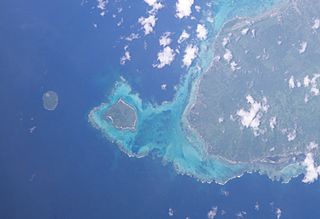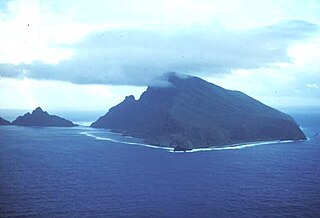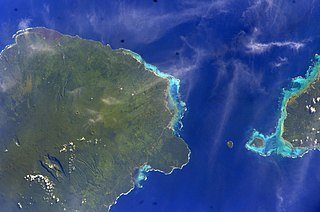Nu'ulopa is a small uninhabited island in the Apolima Strait between the islands of Upolu and Savai'i in Samoa. The island is part of Aiga-i-le-Tai district.

The Apolima Strait is about 13 km wide and separates the two largest islands of Samoa, the island of Savai'i to the northwest, and Upolu to the southeast.

Upolu is an island in Samoa, formed by a massive basaltic shield volcano which rises from the seafloor of the western Pacific Ocean. The island is 75 kilometres long and 1,125 square kilometres in area, making it the second largest of the Samoan Islands geographically. With approximately 145,000 people, it is by far the most populated of the Samoan Islands. Upolu is situated to the southeast of Savai'i, the "big island". Apia, the capital, is in the middle of the north coast, with Faleolo International Airport at the western end of the island. The island has not had any historically recorded eruptions, although three lava flows date back only a few hundred to a few thousand years.

Savaiʻi is the largest and highest island in Samoa and the Samoan Islands chain. The island is the fifth largest in Polynesia, behind the two main islands of New Zealand and the Hawaiian Islands of Hawaii and Maui.
Contents
Nu'ulopa is about 50m high. It is also a small forested rocky outcrop with coconut palms (Cocos nucifera) and a conservation area for flying foxes. The surrounding sea is a conservation area for turtles. [1]

Pteropus is a genus of bats which are among the largest in the world. They are commonly known as fruit bats or flying foxes, among other colloquial names. They live in the tropics and subtropics of Asia, Australia, East Africa, and some oceanic islands in the Indian and Pacific Oceans. There are at least 60 extant species in the genus.
Nu'ulopa sits between another two islands Apolima and Manono. The islands lie on an underwater ridge connecting the two main islands of Upolu and Savai'i.

Manono is an island of Samoa, situated in the Apolima Strait between the main islands of Savai'i and Upolu, 3.4 km WNW off Lefatu Cape, the westernmost point of Upolu.
Nu'ulopa is generally used as a cemetery for the high chiefs (matai) of Manono.

Fa'amatai is the chiefly system of Samoa, central to the organization of Samoan society. It is the traditional indigenous form of governance in the Samoa Islands, comprising American Samoa and the Independent State of Samoa. The term comprises the prefix fa'a and the word matai.













